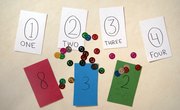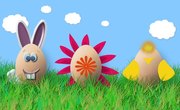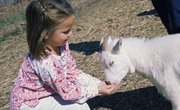Qualitative and quantitative activities give kindergartners a solid foundation for future learning. Qualitative skills enhance language acquisition. Quantitative skills are especially helpful in mastering mathematics. You can plan a lesson around one concept or integrate both into an activity. For example, kindergartners can enjoy a quantitative exercise involving counting apples in a basket, followed by a qualitative activity that includes sorting varieties of apples by color and size, and then sampling their taste.
My Little House
In this qualitative activity, teach kindergartners how to listen, follow directions and understand size and location by having them follow your instructions for drawing a house. Provide each child with paper cutouts of a large square, large triangle, small rectangle, two small squares, a tree, an adult and a child. Instruct children to place the triangle above the large square to construct their house and roof. Next, tell them to add the rectangle for a door and two small squares for windows. Finally, direct the children to place the tree to the right side of the house, and the big person and the little person to the left side of the house. The activity also builds quantitative skills by teaching shapes.
Rubbery Animals
In this qualitative activity, teach the kindergarten students to observe descriptive qualities and grasp temporal concepts related to time, such as before and after. Start by having children roll out a layer of Playdough. Provide cookie cutters of animal shapes and instruct children to make one animal. Have the children gently pull on its legs and neck to stretch it out. Ask students to describe how the animal changed. Children should note that the animal was fatter before and now it’s thinner; also, they should note that the animal was shorter before and now it's taller.
Dinosaur Popularity Contest
In this quantitative activity, introduce children to graphs and surveys with a dinosaur lesson. Provide a handout with the names and pictures of four types of dinosaurs. Make a large chart on the board with four columns for each of the dinosaurs. Tell your students to circle their favorite dinosaur and then go stand in a group with other children who chose the same dinosaur. Explain that you’re conducting a class survey to determine the most popular dinosaur. Have children count the number of students in their group. Place that number under each dinosaur heading on the chart to determine the frequency of each response.
Edible Necklace
In this quantitative activity, teach kindergarten students how to understand patterns by comparing quantities. This activity readies kindergarten students for mathematical operations. Give each child an 18-inch string and a dish of colored O-shaped cereal pieces for them to make a necklace. Pass around a necklace you made earlier using loops of one color. Indicate that they’re going to make a more colorful necklace following a pattern. Explain that the pattern will consist of one loop of one color, followed by two loops of a second color, followed by three loops of a third color. Provide tape so students can tape one end of the string to their desk to keep the cereal from sliding off the string. Children can wear their finished necklace. They can eat the necklace if they don’t have food allergies.
Related Articles
References
Writer Bio
Dr. Mary Dowd is a dean of students whose job includes student conduct, leading the behavioral consultation team, crisis response, retention and the working with the veterans resource center. She enjoys helping parents and students solve problems through advising, teaching and writing online articles that appear on many sites. Dr. Dowd also contributes to scholarly books and journal articles.











